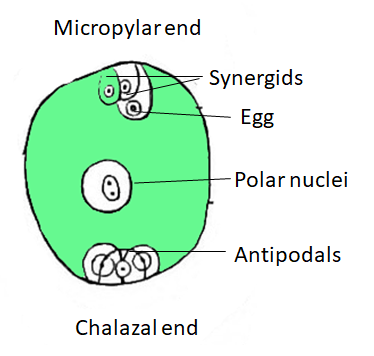
Answer
449.1k+ views
Hint: When the other sperm fuses with them, it forms a triploid cell that develops into the endosperm. The endosperm is a tissue initiated within the seeds of most of the flowering plants following fertilization.
Complete answer:
The secondary nucleus is formed by the fusion of two polar nuclei in the embryo sac of a seed plant preceding fertilization. The secondary nucleus is also known as the primary endosperm nucleus. It is triploid (meaning three chromosome sets per nucleus) in most species. It borders the embryo and supplies nutrition in the form of starch, though it can also contain oils and protein.

The cells of an unfertilized ovule are 8 in number and arranged within the type of 3+2+3 (from top to bottom) i.e. 3 antipodal cells, 2 polar central cells, 2 synergids & 1 ovum. One sperm fertilizes the ovum and the other sperm combines with the 2 polar nuclei of the big central cell of the megagametophyte. The haploid sperm and haploid egg combine to make a diploid zygote, the method being called syngamy, while the other sperm and therefore the two haploid polar nuclei of the big central cell of the megagametophyte organize a triploid nucleus (triple fusion) . Some plants may form polyploid nuclei.
So, the correct answer is ‘Fusion of two polar nuclei’.
Note: The female gametophyte is also called the embryo sac in angiosperms. The large cell of the gametophyte will then become the endosperm, a nutrient-rich tissue that provides nourishment to the developing embryo. The ovary, surrounding the ovules, develops into the fruit, which protects the seeds and should function to disperse them.
Complete answer:
The secondary nucleus is formed by the fusion of two polar nuclei in the embryo sac of a seed plant preceding fertilization. The secondary nucleus is also known as the primary endosperm nucleus. It is triploid (meaning three chromosome sets per nucleus) in most species. It borders the embryo and supplies nutrition in the form of starch, though it can also contain oils and protein.

The cells of an unfertilized ovule are 8 in number and arranged within the type of 3+2+3 (from top to bottom) i.e. 3 antipodal cells, 2 polar central cells, 2 synergids & 1 ovum. One sperm fertilizes the ovum and the other sperm combines with the 2 polar nuclei of the big central cell of the megagametophyte. The haploid sperm and haploid egg combine to make a diploid zygote, the method being called syngamy, while the other sperm and therefore the two haploid polar nuclei of the big central cell of the megagametophyte organize a triploid nucleus (triple fusion) . Some plants may form polyploid nuclei.
So, the correct answer is ‘Fusion of two polar nuclei’.
Note: The female gametophyte is also called the embryo sac in angiosperms. The large cell of the gametophyte will then become the endosperm, a nutrient-rich tissue that provides nourishment to the developing embryo. The ovary, surrounding the ovules, develops into the fruit, which protects the seeds and should function to disperse them.
Recently Updated Pages
Who among the following was the religious guru of class 7 social science CBSE

what is the correct chronological order of the following class 10 social science CBSE

Which of the following was not the actual cause for class 10 social science CBSE

Which of the following statements is not correct A class 10 social science CBSE

Which of the following leaders was not present in the class 10 social science CBSE

Garampani Sanctuary is located at A Diphu Assam B Gangtok class 10 social science CBSE

Trending doubts
Derive an expression for drift velocity of free electrons class 12 physics CBSE

Which are the Top 10 Largest Countries of the World?

Write down 5 differences between Ntype and Ptype s class 11 physics CBSE

The energy of a charged conductor is given by the expression class 12 physics CBSE

Fill the blanks with the suitable prepositions 1 The class 9 english CBSE

Derive an expression for electric field intensity due class 12 physics CBSE

How do you graph the function fx 4x class 9 maths CBSE

The Equation xxx + 2 is Satisfied when x is Equal to Class 10 Maths

Derive an expression for electric potential at point class 12 physics CBSE



